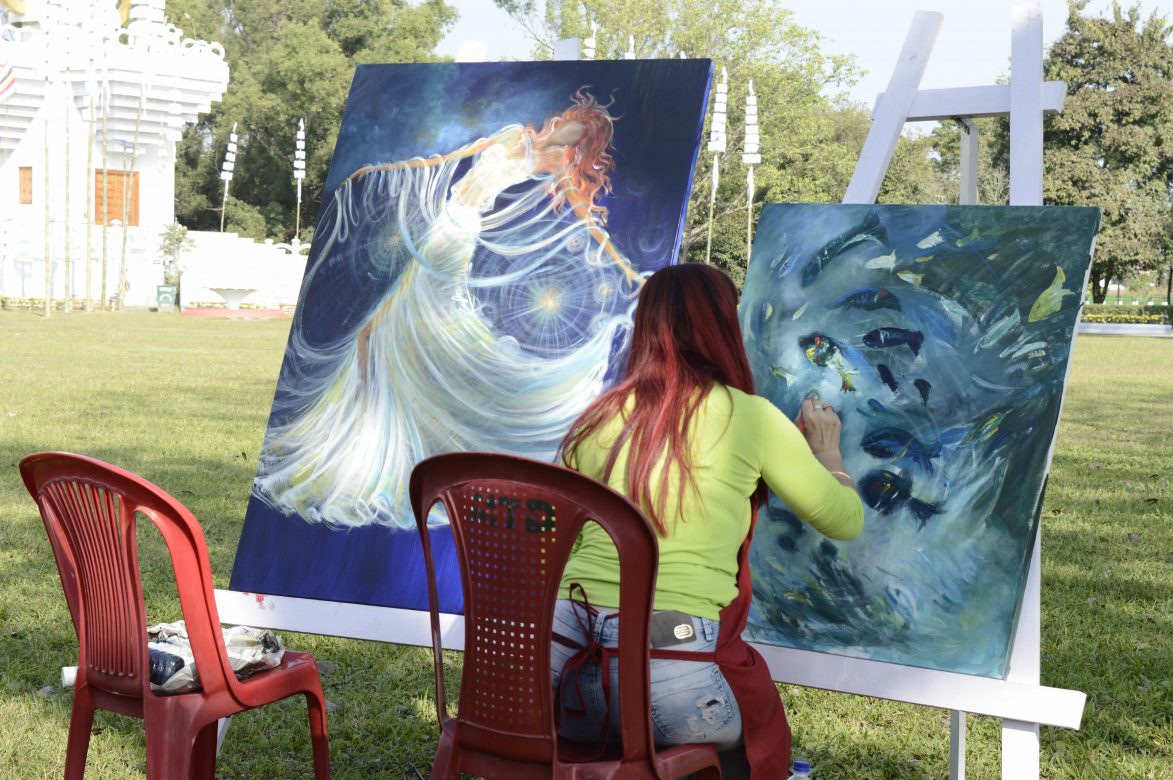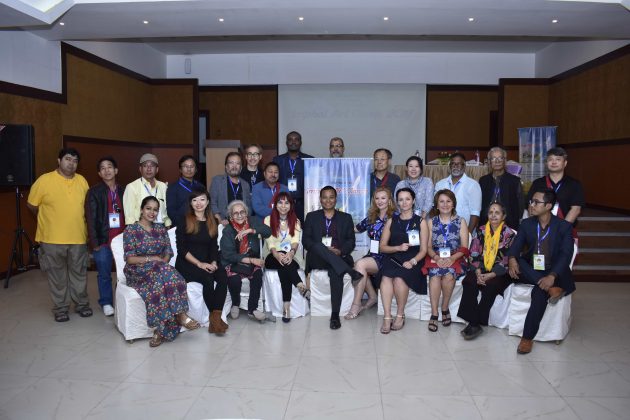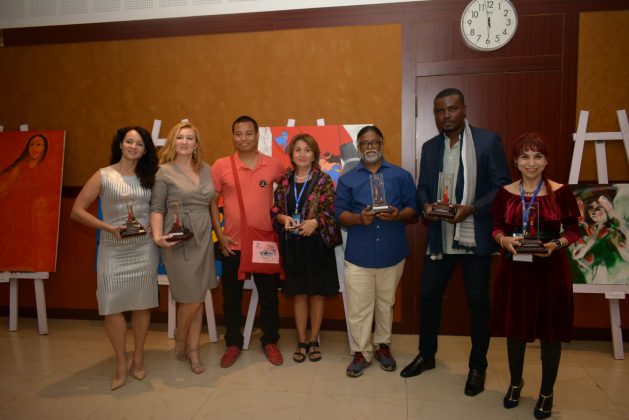 By Moirangthem Monali
By Moirangthem Monali
Manipur, a tiny state in the north-east region of India is well known to the world for its rich cultural heritage in the field of art and culture and sports. Every year Manipur celebrates the Sangai Festival –the biggest festival in the state which is held from 21st till 30th of November. And as a part of it, the 2nd International Imphal Art Camp 2017 was organised by North East Brothers Entertainment Pvt. Ltd. in association with Department of Tourism, Manipur to promote the art of Manipur.
It is important to lay an insight on the art discourse of Manipur before I begin to discuss the works of artists from different parts of the world. Modern art practises in Manipur became active only around the 1970’s and this is mainly because of two reasons: first, the establishment of State Kala Academy and second, the setting up of Arts Society Manipur, the only pioneering art organization. Manipur State Kala Academy and Arts Society Manipur has been playing an important role in the art movement of Manipur by organizing various art activities such as seminars, workshops, exhibitions and symposiums. Apart from this, Imphal Art College, the only Fine Art College in the state has also been contributing a major share in the art scene of the region. Due to the advancement of technology, transport system became more easily accessible and as a result, local artists started to move out of Manipur and were being trained from well established institutes of India. After being exposed to the mainstream Indian art, they began to bring in new waves in the contemporary art of Manipur. And these artists began to search for a ‘new’ identity trying to create their own individual style. Now, let me connect the contemporary art of Manipur with the participants of 2nd International Imphal Art Camp 2017.Imobi Sharma, a well known artist from Manipur is greatly influenced by the Impressionist artist- Gustav Klimt. He incorporates Manipuri elements in his painting and tries to create his own individual style. His works are on great demand in India as well as abroad. Golmei Gandampu’s series of paintings represent the dance forms of Kabui community to which he belongs. He skilfully employs the brushstrokes with swirls to signify the beautiful dance movements. He expressed the Kabui dance is losing its foot and desires to preserve it, through his visual representations. Chandam Lalit is more inclined towards the social issues which prevent him from painting the beauty of nature. Ultimately, he prefers to symbolize the social events through the depiction of female figures with swift brushstrokes. Meena Laishram, the only female artist from Manipur in the camp who is based in Delhi expressed the fond memories of her childhood days through her canvas. Meena’s representation of art is closer to native art with the techniques and the elements that she employs.
The visual arts constitute a language and one can approach an image in terms of its formal elements: line, shape, space, colour, light and shade- and consider its aesthetic impact on the viewer. The exhibition provided a space to reflect back on the contemporary art of Manipur as it gives an idea on how the viewing public perceived it. And interactions with mainland Indian artists provided a glimpse of it. Getting information that Laxman Aelay was participating in the camp, the next day, I went straight to the hotel lobby and told the receptionist, ‘Can you please send a message to Laxmam Aelay that his daughter’s classmate is waiting for him at the lobby.’ After few minutes, we introduced ourselves and began our talk about his works and the art discourse of Manipur. Coming from the weaver’s community of Telangana, Laxman uses local elements to look the world through art. His works are focussed around the socio-political and contemporary situations. He developed his works through his preconceived ideas and subconscious elements. A man of multi talents, he has done video art, photography, installations and logo designs. He feels the contemporary art of Manipur is at its initial stage and need to have discussions, seminars and art documentation more often. On this note, I would also like to urge both young and old artists and people from different walks of life to share the creative space together and interact with one another. This very simple yet big step, will definitely contribute for a place in the mainstream Indian art through a larger perspective. After our conversation, Laxman introduced me to other participants from India -Sobha Broota, Nilen Sen Gupta and Prabhakar Kolte and we sat down together over a cup of tea. Sobha was impressed by the natural beauty of Manipur and of the important role that women play in the society. She praised the hard-working nature of the people of Manipur. Sobha works on oil medium using basic techniques and is inclined towards abstract art. I put up a question to her which is both simple and complex ‘what does art mean to you?’ she replied ‘it is difficult to answer and beyond explanation’ instantly, Prabhakar turned to me and said ‘that is the answer to your question.’ And we all had a good laugh together. The nature of art has been a vexing question for centuries and it has been discussed by artists, poets, philosophers and others. Their views have given us an insight into the creative process but they have not produced a universally acceptable definition of ‘art’.
My second interaction session was with foreign participants from South Korea, Russia, Turkey and Haiti. Song Keun Young, female artist from South Korea uses traditional techniques and concepts. She uses Korean ink and paper which she either makes it by herself or buys it from the market. Her paintings depict the love of reading by the noble man in his study room. To Kim In Tae, Manipur reflects his childhood neighbourhood scene. He paints on acrylic medium and expressed his love for nature. In his painting, he uses flat planes with bright colours and symbols. Julia Zhukova and Elena Brazhunenko from Russia expressed their love for landscape paintings. To Julia, the streets of Imphal city gave her the inspiration to paint and for Elena, Post-Impressionism influences her works. Emine Tokmakkaya, a female artist from Turkey is more into the traditional and mystic concept. Her works focuses on dreams and women. Her painting is more absorbed towards the mystic elements of her cultural background and portrays fish as a good omen. She feels that Indian art and her art has the same concept as both arts are rooted to their traditions. Garry Laurent from Haiti paints as a therapeutic treatment to his country’s sufferings. Garry works on acrylic and most of his works are associated with the play of texture. In his painting he depicts Sangai, the state animal of Manipur from where the Sangai Festival takes its’ name.
The 2nd International Imphal Art Camp 2017 served as a platform for sharing creative ideas and learning each other’s culture and traditions which gave a great impact upon the art fraternity as well as the masses of Manipur. It also played the role of bringing awareness among the intellectuals and common people of Manipur. The camp also gave a space for documenting the artworks of individual artists from across the world. Organizing such camp provides a place for Manipur in the national as well as the international art movement.
Artists, art lovers and the people of Manipur felt the Camp was a laudable experience and expects it with more participation from all disciplines in the future.
The article and photos were sent by N E Brothers and can be reached at nebrothers(at)gmail(dot)com



